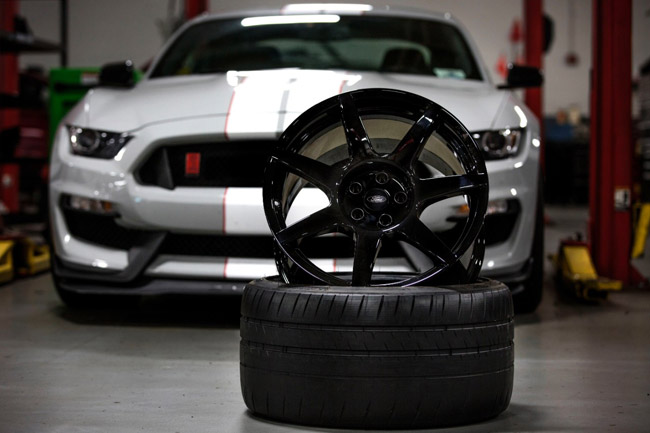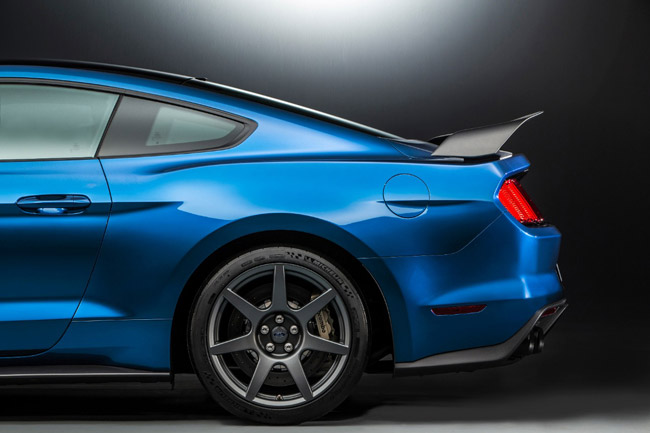
We’ve been waiting on this one for a while. Having reported on concepts, partials and super-expensive equivalents, the idea of seeing a set of carbon fiber wheels come standard on a vehicle, as Ford is reporting with the release of their Shelby GT350R Mustang, is one that we’ve been dying to read about for a long, long time.
Touted as “the most track-capable Mustang ever,†and constructed with the help of Carbon Revolution, an Australian-based carbon fiber supplier, Ford’s new Shelby GT is the first vehicle from a major automotive manufacturer to come off the production line sporting its own set of high-performance carbon fiber wheels.
“Designed, developed and tested with the highest of quality standards in mind, these first-of-a-kind wheels deliver unprecedented chassis performance, massive weight savings and improved driving dynamics,†states Ford’s official press release on the matter.
One such dynamic includes a reduction in weight not supported by the car’s suspension, otherwise known as unsprung weight.

Shedding some 60 pounds, compared to aluminum, the new wheels allow for easier starts and stops, faster turning and a significant decrease in wheel rotational inertia — over 40 percent — which improves acceleration and driver input.
In fact, the wheels are so light, Ford had to recalibrate the Mustang’s dampers and springs because the suspension system was responding far too acutely to the road, making it ride bumpier and wilder than initially desired.
Which begs the question: how safe is a wheel that’s lighter, faster and made up of a material that’s not exactly known for its high-impact durability?
For that, we turn to the tests.
“One of the most severe tests for wheels in the Ford development process involves striking a curb at speed — a test that, without proper design, can cause serious wheel and tire damage.â€
So how did the carbon fiber wheel come out?
“Because of the light weight, advanced construction methods and resins in the wheels… the suspension was able to react so fast that the driver wasn’t sure the test had been carried out correctly.â€
Let’s repeat that last part, shall we?
“…the driver wasn’t sure the test had been carried out correctly.â€
They ran it again, just to be sure, to the same results.
“The suspension response was fast enough to greatly diminish the severity of the impact,†the press release goes on to explain. “That’s the power of minimizing unsprung weight.â€
It’s also the power of rigorous inspection.
In an effort to ensure that each individual product is road ready, while the wheel is being constructed, composed and put into a mold, it’s also being embedded with a personalized RFID chip that makes some 61 individual checks, logging over 246,000 points of data before being sent to a CT machine that then takes over 18,000 X-rays.
Once it has been approved, it is then coated with a resin and drenched in a liquefied ceramic material via a plasma arc gun that creates an “incredibly thin, nearly diamond-hard coating†that shields the wheel from excess heat, reducing maximum temperatures and allowing for continuous use at high speeds.
It’s then finished, according to Ford’s set of standards.
“Carbon fiber parts are notoriously challenging when it comes to delivering a flawlessly smooth painted surface – the kind of finish Ford demands for all of its vehicles. Several proprietary new processes were developed that resulted in a robust, high-gloss black finish that not only looks good, but ensures a long life for the wheels.â€
And more stylish fun for the rider.
“We believe this is a game changer,â€
says Adam Wirth, chassis supervisor of Ford Performance,
“a great example of improved performance through innovation.â€
Innovation that will undoubtedly see us through to the day when all cars come equipped with such rigorously tested, supercool, carbon fiber wheels.
Stay tuned.
What do you think about Ford’s new mass-produced carbon fiber wheels? Like em? Hate em? Let us know in the comments!